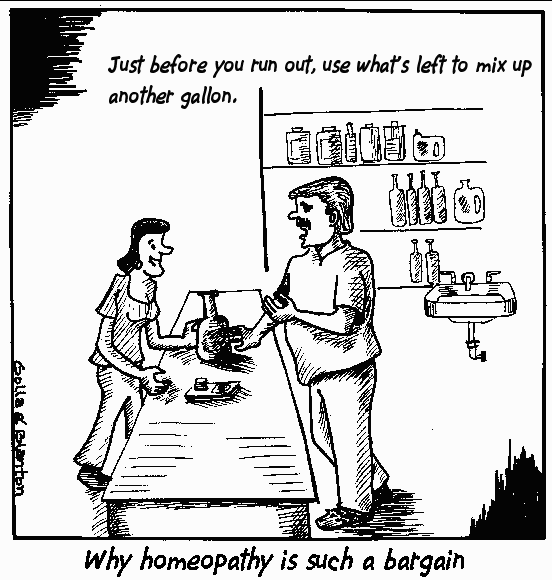Many people confuse the terms “homeopathic” and “naturopathic,” or think that all natural medicines are homeopathic. Not true! Homeopathic medicines are, by definition, diluted past the point of chemical detectability. In a typical homeopathic pill, not a single molecule of the original substance is present. They don’t work because it is not even conceptually possible that they could work (beyond their placebo effect of course). This is why you can swallow a whole bottle of homeopathic sleeping pills without dying from an overdose – you’ve swallowed nothing but lactose.
On the other hand, many natural medicines are perfectly effective in their recommended doses, and often preferable to their laboratory counterparts.
So if you want to take natural medicines but don’t want to waste your money supporting the scumbag snake-oil hucksters who sell homeopathics, how do you tell the difference? The issue gets especially cloudy when you have a single manufacturer selling both variants. Case in point: One of the world’s biggest homeopathic/naturopathic vendors, Boiron, sells Arnica as both a cream and as a homeopathic pill. But there’s a huge difference: The topical cream contains 7% actual Arnica, whereas the pill is a true homeopathic, therefore containing 0% Arnica. Consumers who don’t want to waste their money must read the label to know they’re getting a product that might actually help them.
How to tell the difference? It’s simple once you know the “code”.
Homeopathic “potency” is described with a “C” or an “X” – the more diluted the ingredient, the more potency it’s considered to have (which is of course absurd). For point of comparison, “one third of a drop of some original substance diluted into all the water on earth would produce a remedy with a concentration of about 13C.” Boiron’s Arnica pellets are sold at a dilution of 30C.
So:
1) Sugar pills (i.e. “diluted” homeopathics) will list their “potency” (which is really ​the opposite of their potency) as C or X, whereas actual natural medicine will list the active ingredient as a PERCENTAGE (i.e. 7% actual arnica root).
2) If there is an active ingredient, as with the cream, there will be an “Active Ingredients” section on the back label, listing those active ingredients and their percentages. But with sugar pills, you’ll often see only an “Inactive Ingredients” section (mentioning lactose, etc.) but NO “Active Ingredients” section (because there aren’t any and they can’t legally claim that there are any). So a missing “active ingredients” section on the label can be interpreted as code for “sugar pills.” In some cases, homeopathic pills will have an Active Ingredients section, but with a footnote pointing out in small print that **C, K, CK, and X are homeopathic dilutions.

